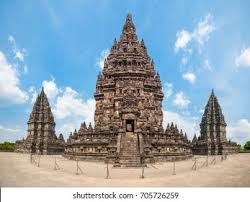Prambanan Trimurti Temples Complex ,Indonesia

Address
Prambanan Trimurti Temples Complex , Candi Sewu, Kranggan, Bokoharjo, Kec. Prambanan, Kabupaten Sleman Daerah Istimewa Yogyakarta 55572, Indonesia
Diety
Trimūrti (Shiva, Vishnu, Brahma)
Introduction
Prambanan or Rara Jonggrang is an 8th-century Hindu temple compound in Special Region of Yogyakarta, Indonesia, dedicated to the Trimūrti, the expression of God as the Creator (Brahma), the Preserver (Vishnu) and the Destroyer (Shiva). The temple compound is located approximately 17 kilometres (11 mi) northeast of the city of Yogyakarta on the boundary between Central Java and Yogyakarta provinces. The temple compound, a UNESCO World Heritage Site, is the largest Hindu temple site in Indonesia and the second-largest in Southeast Asia after Angkor Wat. Prambanan temple compounds originally consists of 240 temple structures; which represents the grandeur of ancient Java’s Hindu art and architecture, also considered as a masterpiece of the classical period in Indonesia.
Puranic Significance
A temple was first built at the site around 850 CE by Rakai Pikatan and expanded extensively by King Lokapala and Balitung Maha Sambu the Sanjaya king of the Mataram Kingdom. A short red-paint script bearing the name “pikatan” was found on one of the finials on top of the balustrade of Shiva temple, which confirms that King Pikatan was responsible for the initiation of the temple construction. After being used and expanded for about 80 years, the temple was mysteriously abandoned by the second of the 10th century. In the 930s, the Javanese court was shifted to East Java by Mpu Sindok, who established the Isyana Dynasty. It was not clear however, the true reason behind the abandonment of Central Java realm by this Javanese kingdom. The inner zone or central compound is the holiest among the three zones. It is the square elevated platform surrounded by a square stone wall with stone gates on each four cardinal points. This holiest compound is assembled of eight main shrines or candi. The three main shrines, called Trimurti (“three forms”), are dedicated to the three Gods: Brahma the Creator, Vishnu the Keeper, and Shiva the Destroyer. The Shiva temple is the tallest and largest structure in Prambanan Rara Jonggrang complex; it measures 47 metres tall and 34 metres wide. The main stairs are located on the eastern side. The eastern gate of Shiva temple is flanked by two small shrines, dedicated to guardian gods, Mahakala and Nandhisvara. The Shiva temple is encircled with galleries adorned with bas-reliefs telling the story of Ramayana carved on the inner walls of the balustrades. To follow the story accurately, visitors must enter from the east side and began to perform pradakshina or circumambulating clockwise. The bas-reliefs of Ramayana continue to the Brahma temple galleries. The Shiva shrine is located at the center and contains five chambers, four small chambers in every cardinal direction and one bigger main chamber in the central part of the temple. The east chamber connects to the central chamber that houses the largest temple in Prambanan, a three-metre high statue of Shiva Mahadeva (the Supreme God). The statue bears Lakçana (attributes or symbol) of Shiva such as skull and sickle (crescent) at the crown, and third eye on the forehead; also four hands that holds Shiva’s symbols: prayer beads, feather duster, and trisula (trident). Some historians believe that the depiction of Shiva as Mahadeva was also meant to personify king Balitung as the reincarnation of Shiva. So, when he died, a temple was built to commemorate him as Shiva. The statue of Shiva stands on a lotus pad on a Yoni pedestal that bears the carving of Nāga serpents on the north side of the pedestal. The other three smaller chambers contain statues of Hindu Gods related to Shiva: his consort Durga, the rishi Agastya, and Ganesha, his son. A statue of Agastya occupies the south chamber, the west chamber houses the statue of Ganesha, while the north chamber contains the statue of Durga Mahisasuramardini depicting Durga as the slayer of the Bull demon. The shrine of Durga is also called the temple of Rara Jonggrang (Javanese: slender virgin), after a Javanese legend of princess Rara Jonggrang. The two other main shrines are those of Vishnu on the north side of the Shiva shrine, and the one of Brahma on the south. Both temples face east and each contain only one large chamber, each dedicated to respected gods; Brahma temple contains the statue of Brahma and Vishnu temple houses the statue of Vishnu. Brahma and Vishnu temple measures 20 metres wide and 33 metres tall.
Special Features
One of the largest Hindu temples in Southeast Asia. Dedicated to the Trimurti of Hinduism — Brahma, Vishnu, and Shiva . The largest three temples, the holiest sites within the main complex, are dedicated to the triad of Hindu gods. Shiva’s temple is the most prominent with Brahma’s temple lying to the south of Shiva’s temple, and Vishnu’s temple lying to the north of Shiva’s temple. Directly parallel to these magnificent temples are three smaller temples, each dedicated to mythological animal figures that provide protection, companionship, and transportation to the aforementioned gods: Garuda, a mythical winged creature, Hamsa the swan, and Nandi the bull.
Century/Period/Age
8th-century
Managed By
UNESCO world heritage site
Nearest Bus Station
Yogyakarta
Nearest Railway Station
Stasiun Yogyakarta
Nearest Airport
Yogyakarta









